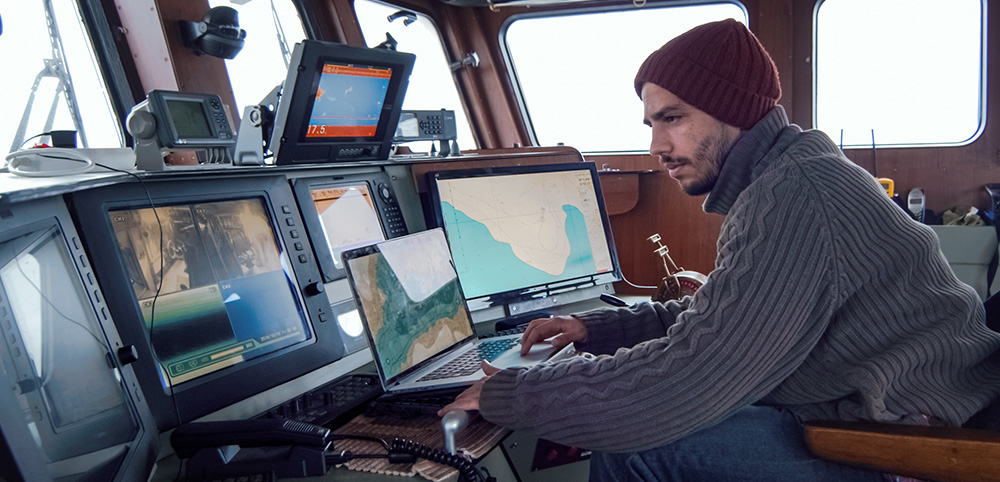As technology advances and industry dynamics evolve, more and more maritime businesses are focusing their time, energy, and resources on digitalization—or is it digitization? These terms are frequently used interchangeably in articles, publications, and conversation, making the differences between them difficult to decipher. And yet, they are not synonymous.
Gartner does a good job differentiating between the two, defining digitization as the move from analog to digital form. Digitization undoubtedly has a place in the maritime world. For example, paper bills of lading typically take 5 to 10 days to reach their destination, creating a strong need for digitized paperwork to facilitate greater efficiency.
Conversely, Gartner defines digitalization as “the use of digital technologies to change a business model and provide new revenue and value-producing opportunities.” It is digitalization that refers to the application of technologies to transform the way things are done and realize substantial value. In the maritime space, ship owners, traders, and tonnage charterers all stand to reap the outsized rewards of an effective digitalization strategy.
Let’s take a closer look at some of the areas that digitalization is transforming in the commercial maritime space.
Data in Context, Enterprise-Wide
In maritime shipping, access to accurate and complete data records is essential to making the right decisions at the right time. But the volume and complexity of data can make continuity difficult to achieve. In fact, just one day in the maritime shipping space surfaces roughly 120 million data points. As a result, many maritime enterprises struggle with a lengthy backlog of data, unable to process information and transmit it to the appropriate places and stakeholders in a timely fashion. While many digitization tools exist in the market, these point solutions tend only to add to the noise of data points being collected – hindering action more than promoting proactive decisions.
With a digitalized approach to data collection, organizations can eliminate data silos and establish a single source of truth from ship to shore. The right digital technology can uphold continuity in even the most challenging circumstances, including operations that are exceedingly complex with a high volume and velocity of activity. By embracing digital workflows beyond simple data collection, maritime businesses can establish end-to-end continuity between chartering, operations, financials, and other functions like bunkering, claims management, and more. All data flows into a single, standard repository, from which users can draw insights based on the contextual information. This results in more accurate assumptions, more informed decisions, and ultimately, better financial outcomes.
Connection among Stakeholders
The global maritime user community is vast and diverse, with approximately 1.2 million people currently employed at sea. Even greater than the number of people in the ecosystem is the volume of emails they transmit. A few years ago, email overload led to the proliferation of email parsing tools, which eliminated the need to sift through thousands of emails and ensured pertinent messages didn’t get lost in cluttered inboxes. Email parsing changed the way stakeholders communicate, but true digitalization doesn’t stop there.
A digital solution that is built with an understanding of individual user needs throughout the maritime ecosystem ensures each constituent is connected to the information they need to perform their respective functions more efficiently and effectively. Modern integration technology enables bi-directional and intentional sharing of information; with the right connective tools, an organization is able to send and recieve data in real time – without clogging an email inbox. By meeting users where they are, digitalization also enables them to engage in the commercial data flow. In fact, cloud-based digital solutions can even bring connectivity without errors or delays onboard the vessel—empowering masters to become active participants in impacting voyage outcomes.
Automation of Key Processes
Tasked with managing commercial and environmental performance while adhering to strict schedules and meeting a myriad of complex operational demands, maritime stakeholders have a lot to worry about on a daily basis. While simple digital tools may help log and track these activities, a Digitalization approach to workflow management enables the automation and enhancement of key processes in a way that boosts productivity and profitability for the entire maritime organization.
Examples of the power of digitally-enabled automation are numerous, including active monitoring of market data, centralized claims management, compliance with recent regulations like IMO 2020, and more. The right digital platform does more than simply storing your data, it automatically and actively manages these functions, while alerting key stakeholders throughout the ecosystem in real time when relevant events or anomalies occur. Equipped with full visibility and real-time alerts, stakeholders are free to focus on value-added tasks, including the use of data to make meaningful changes throughout their maritime operations.
Adopting a Digitalization Mindset
To use “digitization” and “digitalization” synonymously is to neglect the full, transformative potential of digital technologies in the maritime ecosystem. By adopting a digitalization mindset, today’s leading operators, traders, and tonnage charterers can open their businesses to new possibilities and cement their competitive advantage. This opens up opportunities for truly transformational technology, such as predictive analytics, machine learning, artificial intelligence, and more.
At Veson, we are committed to partnering with our clients throughout their digital journeys. As the market’s leading solution for freight and fleet management, our Veson IMOS Platform (VIP) enables the world’s leading buyers and sellers of maritime freight to make the right decisions, at the right time. Our cloud-based solution is designed to move you forward in your digital journey, delivering all of the tools and capabilities you need to ensure data continuity, maximize stakeholder connectivity, and embrace process automation at scale.



 Ayodele Fashakin
Ayodele Fashakin
 Ben Thurecht
Ben Thurecht